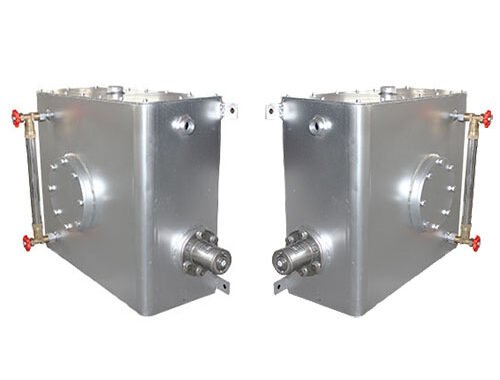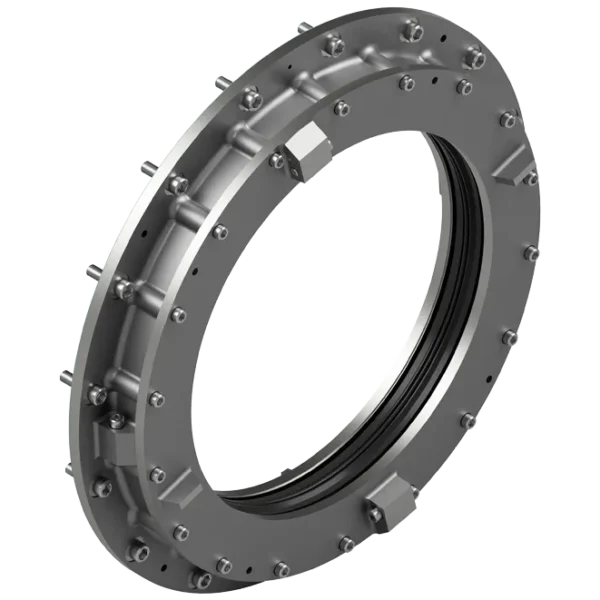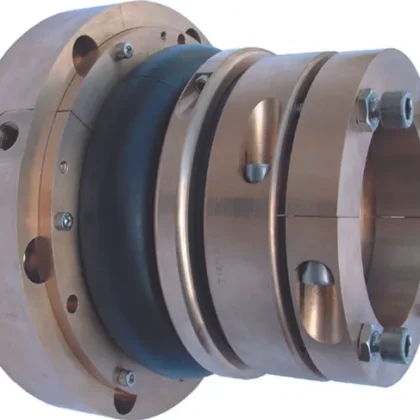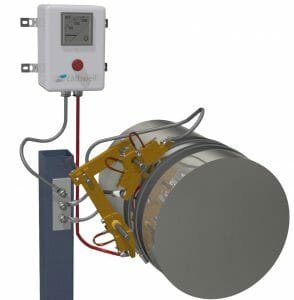A marine shaft lubrication oil tank, commonly known as a stern tube header tank, is a vital component of a vessel’s propeller shaft system.1 Its primary purpose is to provide a gravity-fed supply of lubricating oil to the stern tube, which houses the stern tube bearings and shaft seals.2 This system is critical for preventing seawater from entering the stern tube and for protecting the marine environment from oil leaks.
Function and Working Principle
The stern tube header tank works on a simple but effective principle: hydrostatic pressure.3
- Location: The tank is strategically located in the engine room or shaft tunnel, positioned a few meters above the vessel’s waterline.4
- Positive Pressure: This elevation creates a column of oil that generates a positive pressure inside the stern tube. This internal oil pressure is always slightly higher than the external seawater pressure acting on the aft shaft seal.5
- Protection: This differential pressure ensures that if a seal develops a minor leak, the oil will flow outwards into the sea rather than allowing seawater to contaminate the stern tube’s lubricating oil. This outflow of oil is monitored and kept to a minimum by the sealing system, but the positive pressure is the key mechanism for preventing water ingress.6
- Lubrication: The oil from the tank also lubricates the stern tube bearings, reducing friction and wear, and dissipates heat generated by the rotating shaft.7
Types and Components
While the core principle is the same, there are variations in the system’s design:
- Single-Compartment Tank: The most common design, a single tank serves as both the header and the oil reservoir.
- Double-Compartment Tank: Some systems use two tanks: a high tank for deep-draft conditions and a low tank for shallow-draft or ballast conditions.8 This ensures that the oil pressure remains optimal and excessive oil leakage is avoided.9
- Circulation Systems: On some larger vessels, a circulation pump, oil cooler, and filters are also used in conjunction with the header tank to actively manage oil temperature and cleanliness.10
Key components of the tank and its associated system include:
- Oil Level Gauge/Sight Glass: Allows the crew to visually check the oil level.11
- Level Alarms: Sensors in the tank trigger an alarm if the oil level drops below a set point, indicating a potential leak.12
- Valves: Isolation and drain valves are used for maintenance and to manage the flow of oil.
- Breather Vent: A small vent pipe prevents a vacuum from forming as oil is consumed.
Maintenance and Common Issues
The stern tube header tank requires vigilant monitoring to ensure the integrity of the propulsion system and to protect the environment.13
- Routine Checks: The oil level in the header tank must be checked daily. A sudden or continuous drop in oil level is the first sign of a seal leak.
- Water Contamination: If the stern tube oil becomes contaminated with seawater (which would appear as a milky emulsion), it indicates a failure of the aft seals and a serious problem that requires immediate attention.
- Breather Clogging: A clogged breather can lead to pressure issues, either causing oil to be forced out or a vacuum to form, both of which can compromise the seals.
Spares and Manufacturers
While the tank itself is often a custom-fabricated part of the ship, the related components and spares are supplied by specialist manufacturers.
- Spare Parts:
- Oil Level Sensors and Switches: These are critical for monitoring and safety.14
- Sight Glass and Gaskets: The glass can become cloudy or break, and the gaskets can fail over time.
- Valves and associated piping components.
- Oil Level Sensors and Switches: These are critical for monitoring and safety.14
- Key Manufacturers: The header tank is part of the overall stern tube system, which is supplied by companies like Wärtsilä, Lagersmit, SKF Marine, and Thordon Bearings. These companies also supply the specialized seals and bearings that depend on the tank for lubrication.
We offer an extensive range of marine engine brands and their associated spare parts, providing comprehensive solutions for both main propulsion and auxiliary power needs across diverse vessel types. Our supply capability covers various generations and models, ensuring support for a wide array of marine applications.
Featured Brands and Engine Series/Models:
SULZER:
- Two-Stroke Engines:
- RD/RND Series: RD68, RND76, RND76M, RND90, RND90M (Classic large-bore, low-speed engines, still in operation).
- RLA/RLB Series: RLA(B)56, RLA(B)66, RLA(B)76, RLB90 (Developed two-stroke designs).
- RTA/RT-Flex Series: RTA38, RTA48(T), RTA52, RTA58, RTA62, RTA72, RTA76, RTA84, RTA84M, RTA84C, RTA96 (Modern, fuel-efficient, electronically controlled two-stroke engines).
- Four-Stroke Engines:
- Z Series: ZL40/48, 16ZAV40S (Medium-speed engines).
- RF Series: RF44, RF56 (Often used for auxiliary power or generator sets).
- TAD Series: TAD36, TAD48 (For specific applications).
MAN (including pre and post-MAN B&W models):
- Two-Stroke Engines (KZ, KSZ, K, L, S, MC/MC-C, ME/ME-C): 40/54A, 52/90N, 57/80C, KZ57/80F, KSZ70/125, KSZ78/155, 90/160A, 52/55L, 58/64, 90/190C, L60/105E, 70/120E, 70/125C, L, KSZ78/155A, KSZ70/125B, L52/55A, 40/45 (A broad spectrum covering main propulsion and auxiliary engines).
B&W (Burmeister & Wain – prior to MAN B&W merger):
- MC/MCE Series: L35MC, L60MC, L80MC, L55GFCA, L80GFCA, L80GB, 74VT2BF, K62EF, K74EF, K84EF, K45GFC, K67GFK, K80GFK, K90GFS, 45HU, L70MC (Various generations of two-stroke diesel engines).
- MC-C/ME-C Series: L50MC, S60MC, S70MC, K80MC, S80MC, K90MC-C, L67GFCA, L90GB (Electronically controlled and conventional two-stroke engines).
- VT2BF/EF Series: 50VT2BF, 62VT2BF, K84EF (Older models still in service).
MITSUBISHI:
- UEC/UET Series: UEC37L/LA/LS, UEC45HA, UEC60L/LA/LS, UEC45L/LA/LS, UET45/75C, UEC52/125H, UEC52L/LA/LS, UET45/80D, UEC52/90D, UEC(T)52/105D, UEC45/115H, UEC37/88H, UEC37H (Mitsubishi’s proprietary two-stroke and some four-stroke engine series).
PIELSTICK:
- PA Series: PA6, PC3, PC2-2, IHI PC2-5, PC4, PC2-6, PC4-2L, PC4-570, PA5 (High-speed, compact four-stroke engines, commonly used for generator sets or auxiliary propulsion).
AKASAKA:
- UET/UEC/DM/AH Series: UET45/80D, UEC52/105D, DM51SS, UEC 60/150H, UEC 60H, A31, A34, A37, A41, AH27, AH28, AH30, AH36, AH38, AH40, DM30, DM36, DM38, DM46, DM47 (A prevalent engine brand, particularly in Japanese-built vessels).
DEUTZ:
- RBV/TBD/BVM Series: RBV8M358, RBV8M540, RBV16M640, TBD620L6, BVM350, BVM540, BF6M716 (Various four-stroke medium- and high-speed diesel engines for auxiliary and smaller main propulsion applications).
HANSHIN:
- EL/LH/LU/LUN/LUD/LUS Series: EL30, EL32, EL35, EL40, EL44, LH28RG, LH31G, LU28(A,R,G), LU32, LU35, LU38, LU46(A), LU50, LU54, LUN28, LUN30, LUD32, LUD35, LUS38 (Another significant engine brand commonly found in Japanese vessels).
NIIGATA:
- MG/M Series: MG40X(EX), M34X, 6M28BF, TM31X (Medium-speed diesel engines, typically used in small and medium-sized vessels).
MAK:
- M/MU/AK/AKM Series: M332, M453AK, MU551AK, MU552AK, M601, MU452AK, 451AK, 6M453AK, 9M453C, 6M601C, 8M601 (Medium-speed four-stroke engines, widely used in various marine applications).
WARTSILA:
- 20/22/26/32/38/46/GD/TKR Series: 22, 32, 31, 26, 20S, 28, 38, 46, 32GD, 46GD, 14, TKR22, HFR-V32, NOHAB (Wärtsilä’s broad portfolio of medium- and high-speed diesel engines for main propulsion, auxiliary, and generator sets).
DAIHATSU:
- PS/PKT/DS/DL/DK/PL Series: PS-18, PS-22, PS-20, PS-26, PS-30, PKT-14, PKT-16, PKTD-16, DS-18, DS-22, DS-26, DS-28, DS-32, DL-14, DL-16, DL-19, DL-20, DL-22, DL-24, DL-26, DK-20, PL-24 (Compact and reliable engines primarily used for auxiliary power and generator sets).
CUMMINS:
- BT/CT/NT/KTA/QSK/QSM Series: 4BT3.9, 6BT(A)5.9, 6CT8.3, NT(A)855, N14, KTA19, KTA38, KTA50, QSK19, QSM11 (Robust and durable engines for marine auxiliary power, generator sets, and some smaller main propulsion applications).
CATERPILLAR:
- 3000/3100/3300/3400/3500/3600 Series & C Series: 3054, 3056, 3066, 3106, 3126, 3306, 3406, 3408, 3412, 3508, 3512, 3516, 3606, 3608, 3612, 3616, 3618, C1.5, C2.2, C7, C9, C10, C12, C15, C16, C18, C30, C32 (Reliable and widely used engines across a vast range of main propulsion, auxiliary, and generator set applications).
SCANIA:
- DI Series: DI 09, DI 13, DI 16 (High-performance diesel engines designed for marine applications, typically used as auxiliary and smaller main propulsion engines).




